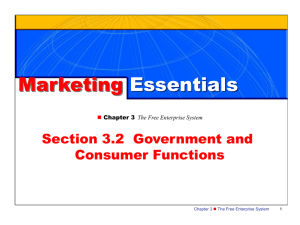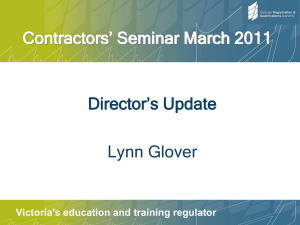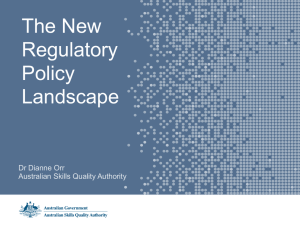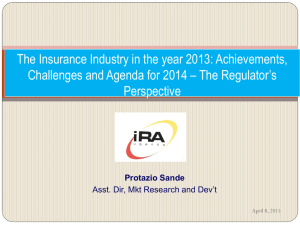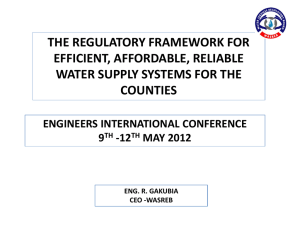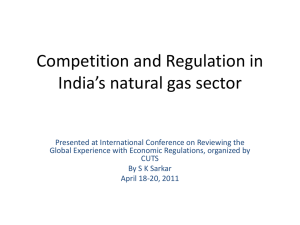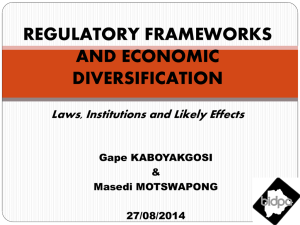Financial Regulation: A Game Theory Approach
advertisement
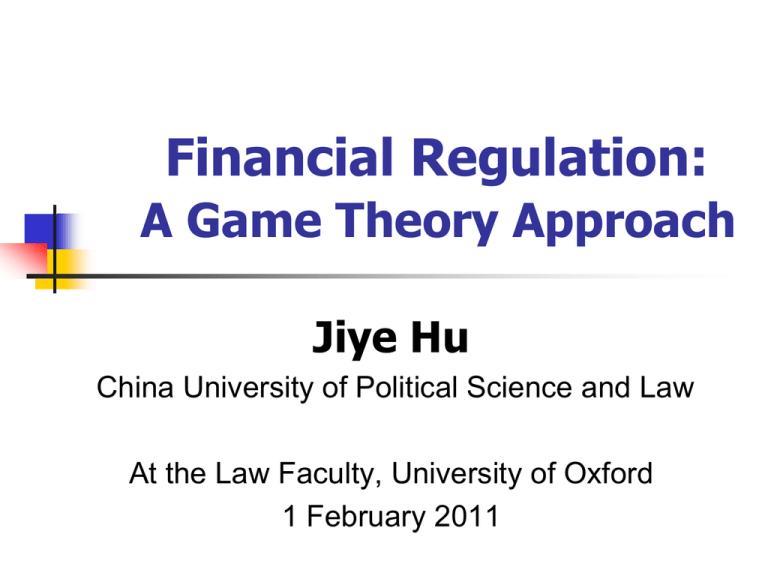
Financial Regulation: A Game Theory Approach Jiye Hu China University of Political Science and Law At the Law Faculty, University of Oxford 1 February 2011 Outline Why Game Theory? A Mixed Strategy Model Application Legislation Why Game Theory? The formulation of Nash equilibrium has had a fundamental and pervasive impact on economics and social sciences, which is comparable to that of discovery of the DNA double helix in the biological sciences. Roger B. Myerson (2007 Nobel Prize laureate), “Nash Equilibrium and the History of Economic Theory”, Journal of Economic Literature 37,1067-1082, 1999. Why Game Theory? Game theory's method is to simplify a situation by describing it in terms of players, actions, payoffs, after which the players' strategic interactions can be described. Whether used explicitly or implicitly, this is a highly useful approach to law. Two Books: Game Theory and the Law Baird et al., Harvard University Press , 1994. Game Theory and the Law Rasmusen, Eric, Cheltenham, UK, 2007. A Mixed Strategy Model Who is regulator ? European Banking Authority European Securities and Markets Authority European Insurance and Occupational Pensions Authority Who is regulatee ? Commercial Banks Security companies Insurance companies, pension funds …… A Mixed Strategy Model Two strategies for both side: two options can be selected by the regulator (G): audit or not two options can be selected by the regulatee (P) : false claim or not Assume they are both rational economic men goals of regulator are detect false claimers and punishment goals of regulatee are to maximize their utility, by falsely claim as much as possible under the condition of weak supervision A Mixed Strategy Model REGULATEE (P) R E G U L A T O R (G) False claim (γ) True claim(1-γ) Audit (θ) B-C, -F -C, 0 Non-audit (1-θ) -R, E 0, 0 A Mixed Strategy Model Assuming the regulatee’s probability of false claim is γ, regulator’ expected benefits with auditing (in the upper line) or not (in the under line) are, respectively: In the upper line: G(1, ) ( B - C ) (-C )(1- ) B - C In the under line: G(0, ) - R 0(1- ) - R A Mixed Strategy Model According to the basic assumption that regulatee does everything to escape audition, γ* maybe the optimum probability of offence. Then the regulator’ expected benefits are the same no matter how he audits or not. Let Upper line=Under line, can calculate the optimum probability of γ *: * C B R We can drawing the result below; if we change cost C to C’, we can get another γ ‘*: Y: Regulator’s pay-off F’ F C 0 B+R-C γ* C’ C X: Regulatee’s false probability 1 A Mixed Strategy Model Similarly, we can calculate the regulator’s optimum audit probability. Given probability of audition θ, regulatee’s expected benefits with offending (in the left column) or not (in the right column) are, respectively: In the left column : G( ,1) (- F ) E(1- ) E - ( E F ) In the right column : G( ,0) 0 0(1- ) 0 A Mixed Strategy Model According to the basic assumption that regulator do his best to catch offence, θ* is the optimum probability of audit. Then the regulatee’s expected pay-off is the same no matter how regulator audits or not. Let left column = left column, can calculate the optimum probability of θ *: * E EF We can drawing the result below; if we change cost F to F’, we can get another θ ‘*: E Y: Regulatee’s pay-off θ* 1 0 E F X: Regulator’s audit probability F F’ A Mixed Strategy Model It means, the regulator audits in the probability of θ *, regulatee offends by the probability of γ* , accordingly. Here, regulatee’s offence probability depends not on himself, but on the regulator: the lower execution cost C for regulator, and the more bonus B and reputation R, the more difficult for regulatee to commit. Similarly, the audit probability of regulator mainly depends on regulatee’s expected benefit E and punishment F, rather than on his own characteristic -------Regulation dilemma Application to Legislation What could we learn from the model? For the regulatee, if the regulator has a lower execution cost C, whilst more bonus B and reputation R, he will be less false claim. Here is a good example: Hong Kong’s Independent Commission Against Corruption. ICAC’s R is very large, so there is less false claim and corruption in HK. Obviously, when E >F, regulatee chooses to violate law because punishment is insignificant even probably being detected. Only if legal power F is much stronger than offensive profits E, does regulatee choose to obey the law, therefore the stronger legal power F is, the lower probability offences happen and audition taken Application to Legislation What could we learn from the model? For the regulator, if the regulatee faces a lower extra income E, whilst less fine F, he will be induced to perform less audit. It means the regulator are lazy to do their work because they believe the regulatee will not “worth” to false claim. Obviously, when B and R are large enough, regulator will be encouraged to audit. Application to Legislation So in Legislation, we can: Enlarge R, B, F for both encourage the regulator and threaten the regulatee; In a real world, B, F can only be increased to a certain extent, and reputation R can be relied on to fill the gaps The education of regulators is necessary, and they must have well qualified in good education history, current working sense of honour, and bright Prospects for the future. Application to Legislation So in Legislation, we can: Reduce the extra income E, lessen the seduce for the regulatee. This will be a little difficult in legislation; more useful in law enforcement Reduce the regulation cost C, to let the regulatee accept lower probability in false claim. “Centrelink” of Australia mainly uses off-site audition, their cost will be lower then other countries. - China Regulation Law over Banking Article 23: The banking regulatory authority shall conduct off-site supervision of the business operations and risk profile of the financial institutions of the banking industry…… Application to Legislation As market failures, the financial factor need to be regulated; Based on the regulation theories, we can construct a mixed strategy game theory model, to simplify and describe the relationship between regulator and regulatee. From the model, we know that regulator’s reputation and bonus larger is better, whilst their regulation cost lower is better Application to Legislation In the mean time, enlarge the regulatee’s false punishment and reduce its expect of false claim, will benefit the regulation effect. The regulation cost of regulator is a extremely important element, it not only related the cost-benefit analysis for the regulator himself, but also impact the regulatee’s false probability Thank you! jiyeh@cupl.edu.cn
